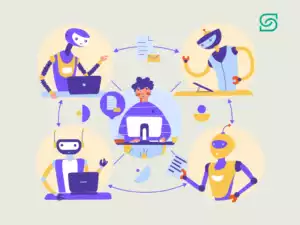
IT support teams are constantly under pressure to resolve issues quickly. But let’s be honest—most ticketing systems are far from perfect. Tickets get lost, responses are slow, and users get frustrated.
The good news? You can fix these inefficiencies with the right strategies. Whether you’re using IT helpdesk software like HaloPSA, Zendesk, Freshservice, or ServiceNow, or have an internal system, these actionable steps will help you optimize workflows, reduce resolution times, and improve user satisfaction.
1. Fix the Root Causes of Slow Ticket Resolutions
Before adding new tools or automation, analyze what’s slowing your team down right now. Some common bottlenecks include:
- Poor ticket categorization – Support teams waste time figuring out priorities manually.
- Lack of automation – Routine tasks (like password resets) eat up valuable agent time.
- Inefficient ticket routing – Tickets are assigned to the wrong teams or people, leading to delays.
- Limited self-service options – Users submit tickets for issues they could solve themselves.
Fix It: Start by auditing your current system. Identify where tickets pile up and implement targeted solutions, such as better categorization rules, automation, and self-service knowledge bases.
2. Use Intelligent Ticket Routing (Not Just “First Come, First Serve”)
Many IT teams still assign tickets manually or use a simple round-robin system. This often means:
- The wrong people get assigned to complex issues.
- Some agents are overloaded while others sit idle.
- Critical tickets don’t get resolved fast enough.
Fix It: Implement intelligent ticket routing based on:
- Issue type & complexity – Password resets go to Tier 1, security breaches to Tier 3.
- Agent expertise – Assign database-related tickets to DB specialists.
- Workload balancing – Distribute tickets evenly to prevent bottlenecks.
Most IT helpdesk software (like Jira Service Management or ServiceNow) allows for AI-powered ticket assignment to speed up response times.
3. Automate Repetitive Tasks with AI & Chatbots
IT support teams waste hours on basic, repetitive tickets—password resets, VPN access issues, software installation requests, etc. Instead of using human agents for these, let automation handle them.
Fix It:
- Deploy AI chatbots to resolve common issues without agent intervention.
- Use automated workflows to approve routine requests instantly (e.g., software access).
- Set up canned responses for frequently asked questions.
Example: Microsoft Teams Helpdesk Bot can handle 70% of basic IT requests without needing human intervention, reducing ticket volume significantly.
4. Implement SLAs (And Actually Enforce Them)
Service Level Agreements (SLAs) define how fast IT teams should respond and resolve issues. But having an SLA is useless if no one follows it.
Fix It:
- Set realistic SLAs based on ticket priority (e.g., Critical: 1-hour response, Low: 24 hours).
- Automate SLA tracking—most IT support ticketing systems have built-in SLA monitoring.
- Use SLA breach alerts to notify managers when a ticket is at risk of missing its deadline.
Pro Tip: Publicly share SLA response times so users know what to expect. It manages expectations and reduces unnecessary follow-ups.
5. Reduce Ticket Volume with Self-Service Options
Many IT tickets don’t need to be submitted in the first place. Users often raise tickets for issues they could fix themselves—if they had the right information.
Fix It:
- Build a searchable knowledge base (FAQs, troubleshooting guides, tutorials).
- Enable self-service password resets (Microsoft Active Directory can automate this).
- Use AI-powered suggestions to recommend help articles before a user submits a ticket.
Example: Companies using self-service knowledge bases report a 30-50% drop in ticket volume, allowing IT teams to focus on more complex issues.
6. Track Key Metrics & Continuously Improve
If you’re not tracking performance, you won’t know what to fix. Some of the most important metrics to monitor include:
Key Metrics to Track:
- First response time (FRT): How fast agents reply to new tickets.
- Mean time to resolution (MTTR): How long it takes to resolve issues.
- Ticket backlog: The number of unresolved tickets in the queue.
- User satisfaction (CSAT): Feedback from users after issue resolution.
Fix It: Use analytics dashboards in your IT support ticketing system (Zendesk, ServiceNow, etc.) to spot trends and bottlenecks. If certain issue types consistently take too long, dig deeper and optimize workflows accordingly.
7. Foster a Culture of Proactive IT Support
Instead of always reacting to tickets, be proactive in preventing issues.
Fix It:
- Monitor systems for early signs of failure (server performance, security threats).
- Send proactive alerts (e.g., “VPN maintenance scheduled” to reduce support calls).
- Conduct regular IT training for employees to reduce common mistakes.
Example: Some IT teams proactively replace outdated hardware and software before they fail, reducing emergency tickets by 40%.
Final Thoughts: Small Changes = Big Impact
Improving your IT support ticketing system isn’t about adding more tools—it’s about fixing inefficiencies, automating repetitive tasks, and empowering users to solve basic issues.
- 1. Start with an audit to find bottlenecks.
- 2. Use automation & intelligent routing to speed up resolutions.
- 3. Implement self-service options to reduce ticket volume.
- 4. Track metrics & continuously improve.
By making these changes, you’ll cut down response times, reduce IT workload, and improve overall business efficiency.
Now Your Turn to Share!
What’s the biggest challenge in your IT support process? Connect with us today to explore the best strategies for optimizing IT support efficiency and faster issue resolution.






